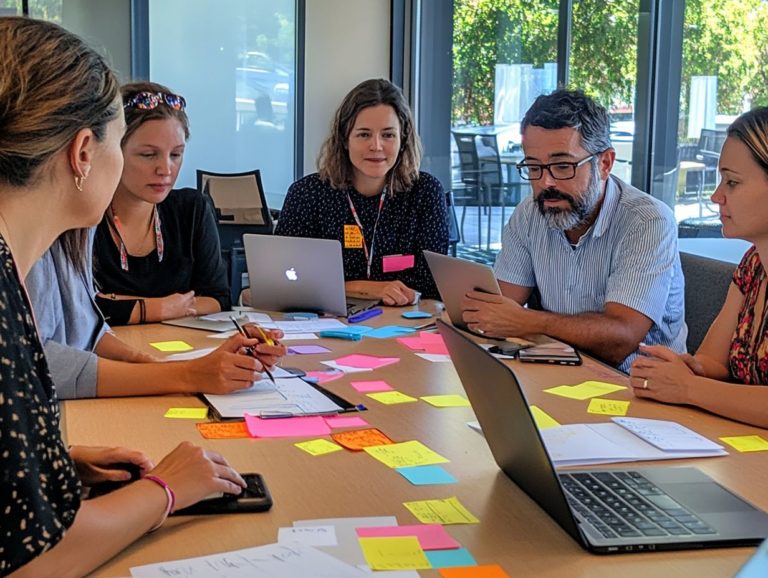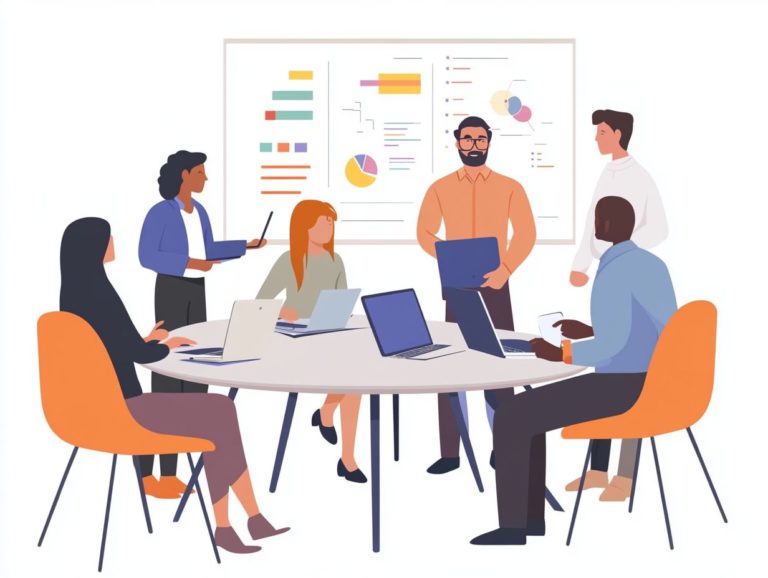Creating Engaging Skill Enhancement Content
In today’s fast-paced world, improving your skills is vital. Understanding your audience and creating engaging content will drive your success.
This article explores strategies for creating impactful content that resonates with learners. You’ll discover how to identify your target audiences, use different formats, and add interactive elements.
It also covers the importance of measuring success, collaborating with industry experts, implementing effective marketing strategies, and the need for regularly updating your content.
Jump in to discover exciting ways to enhance your skills!
Contents
- Key Takeaways:
- The Importance of Skill Enhancement
- Identifying Your Target Audience
- Creating Engaging Content
- Measuring the Impact of Your Content
- Collaborating with Experts
- Promoting Your Content
- Evaluating and Updating Your Content
- Frequently Asked Questions
- What is the importance of creating engaging skill enhancement content?
- How can I make my skill enhancement content more engaging?
- What are some common mistakes to avoid when creating skill enhancement content?
- How can I ensure that my skill enhancement content is effective?
- Do I need technical skills to create engaging skill enhancement content?
- How can I make my skill enhancement content accessible to everyone?
Key Takeaways:

- Continuously improving skills is crucial for personal and professional growth.
- Understand your target audience’s needs and goals to create effective skill enhancement content.
- Utilize different formats and interactive elements to engage and enhance the learning experience.
The Importance of Skill Enhancement
Skill enhancement is essential in today s competitive landscape. It promotes ongoing learning among employees and aligns with your organization s goals.
Investing in Learning and Development initiatives cultivates a growth culture. This equips your workforce to handle digital changes and emerging trends.
Personalized training programs, mentorship opportunities, and digital tools can significantly enhance employee development. They effectively close skill gaps and drive the performance metrics that matter.
Why Continuous Improvement is Crucial
Continuously improving your skills is essential for both you and your organization. It allows you to close skill gaps and elevate your overall performance metrics.
In today’s fast-paced work environment, where technology and market demands evolve rapidly, this necessity becomes even more critical. Embracing a culture of continuous learning contributes to your personal growth while fostering innovation and adaptability within your teams.
Digital tools, like data analytics the process of examining data to improve decision-making empower you to assess your performance and customize your learning paths. Meanwhile, AI integration can offer personalized recommendations for skill development. For instance, using learning management systems software that helps you manage and deliver training programs online that adapt based on your progress ensures you and your organization remain competitive and agile.
Identifying Your Target Audience
Identifying your target audience is crucial for crafting impactful skill enhancement programs. These programs should cater specifically to the unique needs of employees, training managers, and HR specialists within the realm of Learning and Development.
Understanding who you re addressing allows you to tailor your approach, ensuring that the programs resonate and provide maximum value.
Understanding Their Needs and Goals
Understanding the unique needs and goals of your target audience is essential for crafting tailored training programs that enhance employee development.
You can use assessment tools, such as surveys, focus groups, and performance reviews, to gather valuable insights into employee competencies and identify areas needing improvement. By analyzing this data, you can establish SMART objectives Specific, Measurable, Achievable, Relevant, and Time-bound that align seamlessly with individual ambitions and broader organizational goals.
Consider the example of a technology firm that successfully rolled out a training program to upskill their workforce in data analytics. This strategic initiative resulted in a remarkable 30% increase in project efficiency. This tailored approach not only met employee needs but also propelled the company toward its strategic objectives.
Don’t wait! Start enhancing your skills today and stay ahead of the curve!
Creating Engaging Content

Creating engaging content is essential for effective training programs. It captures learners’ attention and enhances retention.
By incorporating storytelling techniques and interactive learning formats, you can elevate the learning experience and ensure that the material resonates with your audience.
Utilizing Different Formats and Mediums
Using various formats and mediums in your training content addresses diverse learning preferences and improves skills.
Embracing microlearning means delivering training in bite-sized segments. This approach makes it easier for employees to digest information and retain what they learn. It allows learners to progress at their own pace, especially useful with mobile access. Imagine engaging with lessons during your commute or lunch break it’s learning made convenient.
eLearning platforms have revolutionized professional development, offering interactive modules and assessments. Companies like Google and IBM have harnessed these formats, resulting in greater engagement and improved skill application among their teams.
Incorporating Interactive Elements
Adding interactive elements to your training programs can significantly elevate learner engagement and retention.
Utilizing techniques like quizzes, simulations, and collaborative projects creates an immersive experience that resonates with participants. Digital tools such as online quiz platforms and simulation software enhance these interactive elements by providing instant feedback and personalizing the learning journey. Encouraging teamwork through collaborative projects allows learners to share insights and develop problem-solving skills.
These techniques not only enhance comprehension but also empower learners to take charge of their education. This transforms the training process into an enjoyable and effective experience.
Measuring the Impact of Your Content
Measuring the impact of your content is essential for assessing the effectiveness of training programs. This process ensures that programs align with employee development objectives and meet key performance metrics.
Key Metrics to Track
Identifying key metrics is crucial for evaluating the effectiveness of your training initiatives and overall learner engagement.
Metrics such as completion rates reveal how many participants are engaged with the training. Gathering learner feedback provides valuable insights into their experiences, highlighting areas for improvement. Assessing the application of skills in the workplace helps determine whether training translates into real-world results.
By analyzing these indicators, you can refine your future training strategies, ensuring they are effective and aligned with the evolving needs of your teams and the broader industry landscape.
Collaborating with Experts

Engaging with experts through mentorship programs and partnerships with industry leaders can significantly elevate your employee development initiatives.
These collaborations offer invaluable insights and practical knowledge that can transform your team’s skill set and overall effectiveness.
Benefits of Partnering with Industry Leaders
Partnering with industry leaders presents many advantages for employee development. You gain access to the latest information and customized training opportunities tailored to your team’s needs.
These collaborations create invaluable networking opportunities. Your staff can connect with experts and peers who provide essential insights and guidance. Sharing resources between organizations enhances the quality of training materials, ensuring employees engage with the latest tools and practices in their field.
For instance, a technology firm teamed up with a prestigious educational institution to create a unique training program. This initiative elevated the staff’s proficiency in emerging software and nurtured a culture of continuous learning. Such partnerships illustrate how strategic collaborations can lead to significant advancements in workforce capabilities.
Promoting Your Content
Effectively promoting your content is essential for reaching your audience and maximizing engagement. By leveraging thoughtfully designed digital tools and smart marketing methods, you can ensure your message resonates with those who matter most.
Effective Marketing Strategies
Implementing effective marketing strategies is crucial for driving learner engagement and ensuring the success of your training programs. Exploring a variety of marketing tactics can make a remarkable difference.
Don’t miss out on targeted ads to reach the right audience. Position your training program directly in front of those actively seeking development. Additionally, working with popular figures who can promote your program adds credibility and authenticity, making your program more appealing.
Robust content marketing strategies like creating valuable resources related to your training material capture interest and encourage participation. By seamlessly blending these approaches, you can significantly enhance your visibility and foster greater engagement among potential learners.
Evaluating and Updating Your Content
Evaluating and updating your content is essential for enhancing training programs to align with evolving standards of learner engagement and effectiveness. This proactive approach ensures that your offerings remain relevant and impactful, fostering an environment of continuous improvement.
Continuously Improving to Meet Changing Needs

Continuously enhancing your training content to align with evolving needs is crucial in today s digital transformation landscape.
This requires harnessing new technologies to elevate the learning experience and attuning to learner feedback. Ensure your materials connect with employees. Regularly analyzing industry trends helps pinpoint shifts in skill demands and emerging best practices.
Implementing these strategies boosts training effectiveness and cultivates a dynamic learning environment that adapts to both individual and organizational growth, resulting in a more engaged and proficient workforce.
Frequently Asked Questions
What is the importance of creating engaging skill enhancement content?
Engaging skill enhancement content is important because it helps individuals learn new skills interactively. For guidance on creating such content, refer to this resource on how to build a skill enhancement curriculum. It keeps their attention and improves retention of the information.
How can I make my skill enhancement content more engaging?
There are several ways to make your content more engaging. Use multimedia elements like videos and images, incorporate interactive activities and quizzes, and utilize storytelling techniques to make the content relatable.
What are some common mistakes to avoid when creating skill enhancement content?
Common mistakes include using jargon or technical terms without explanations, not considering the target audience’s needs, and failing to use a variety of teaching methods to keep content interesting.
Start enhancing your training programs today and watch your employee engagement soar!
How can I ensure that my skill enhancement content is effective?
Clearly define your learning objectives. Use relevant, up-to-date information and gather feedback from learners to continually improve your content.
Do I need technical skills to create engaging skill enhancement content?
No, technical skills aren’t required! Basic strategies for teaching effectively and familiarity with content creation tools can be very helpful.
How can I make my skill enhancement content accessible to everyone?
Make your skills accessible to all! Use alternative text for images, provide transcripts for audio, and keep your language clear and simple.






